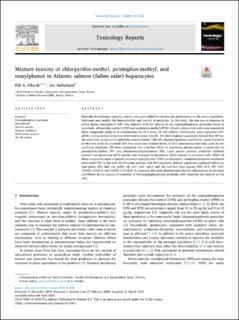| dc.contributor.author | Olsvik, Pål Asgeir | |
| dc.contributor.author | Søfteland, Liv Ingeborg Rosvoll | |
| dc.date.accessioned | 2021-03-19T12:56:39Z | |
| dc.date.available | 2021-03-19T12:56:39Z | |
| dc.date.created | 2021-01-26T18:20:37Z | |
| dc.date.issued | 2020 | |
| dc.identifier.citation | Olsvik, P. Å. & Søfteland, L. (2020). Mixture toxicity of chlorpyrifos-methyl, pirimiphos-methyl, and nonylphenol in Atlantic salmon (Salmo salar) hepatocytes. Journal of Clinical Nursing, 7, 547-558. doi: | en_US |
| dc.identifier.issn | 2214-7500 | |
| dc.identifier.uri | https://hdl.handle.net/11250/2734507 | |
| dc.description.abstract | Pesticide formulations typically contain adjuvants added to enhance the performance of the active ingredient. Adjuvants may modify the bioavailability and toxicity of pesticides. In this study, the aim was to examine to which degree nonylphenol (NP) may interfere with the toxicity of two organophosphorus pesticides found in aquafeeds, chlorpyrifos-methyl (CPM) and pirimiphos-methyl (PPM). Atlantic salmon liver cells were exposed to these compounds singly or in combinations for 48 h using 3D cell cultures. Cytotoxicity, gene expression (RT-qPCR), and lipidomics endpoints were used to assess toxicity. The dose-response assessment showed that NP was the most toxic compound at equimolar concentrations (100 μM). Shotgun lipidomics pointed to a general pattern of elevated levels of saturated 18:0 fatty acids and declined levels of 18:1 monounsaturated fatty acids by the combined treatment. All three compounds had a distinct effect on membrane phospholipids, in particular on phosphatidylcholine (PC) and phosphatidylethanolamine (PE). Lipid species patterns predicted inhibited stearoyl CoA desaturase (SCD) activity and increased Δ6 desaturase (D6D) activity in co-treated cells. While all three compounds alone mitigated increased triacylglycerol (TAG) accumulation, combined treatment resulted in lower total TAG in the cells. Multivariate analysis with PLS regression showed significant combined effects for nine genes (d5d, d6d, scd, srebf2, vtg, esr1, cyp1, ugt1a, and cat) and four lipid species (FFA 22:5, LPC 18:0, TAG52:1-FA16:0, and TAG52:1-FA18:0). In summary, this study demonstrates that the adjuvant can be the main contributor to the toxicity of a mixture of two organophosphorus pesticides with relatively low toxicity in fish cells. | en_US |
| dc.language.iso | eng | en_US |
| dc.publisher | Elsevier | en_US |
| dc.rights | Navngivelse 4.0 Internasjonal | * |
| dc.rights.uri | http://creativecommons.org/licenses/by/4.0/deed.no | * |
| dc.title | Mixture toxicity of chlorpyrifos-methyl, pirimiphos-methyl, and nonylphenol in Atlantic salmon (Salmo salar) hepatocytes | en_US |
| dc.type | Peer reviewed | en_US |
| dc.type | Journal article | en_US |
| dc.description.version | publishedVersion | en_US |
| dc.rights.holder | © Forfatterne, 2020 | en_US |
| dc.subject.nsi | VDP::Matematikk og Naturvitenskap: 400 | en_US |
| dc.subject.nsi | VDP::Matematikk og Naturvitenskap: 400::Zoologiske og botaniske fag: 480::Økotoksikologi: 489 | en_US |
| dc.source.pagenumber | 547-558 | en_US |
| dc.source.volume | 7 | en_US |
| dc.source.journal | Toxicology reports | en_US |
| dc.identifier.doi | 10.1016/j.toxrep.2020.03.008 | |
| dc.identifier.cristin | 1879879 | |
| dc.relation.project | Norges forskningsråd: 244507 | en_US |
| dc.relation.project | Norges forskningsråd: 254807 | en_US |
| dc.description.localcode | Unit Licence Agreement | en_US |

